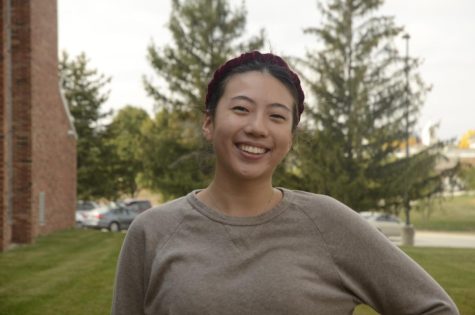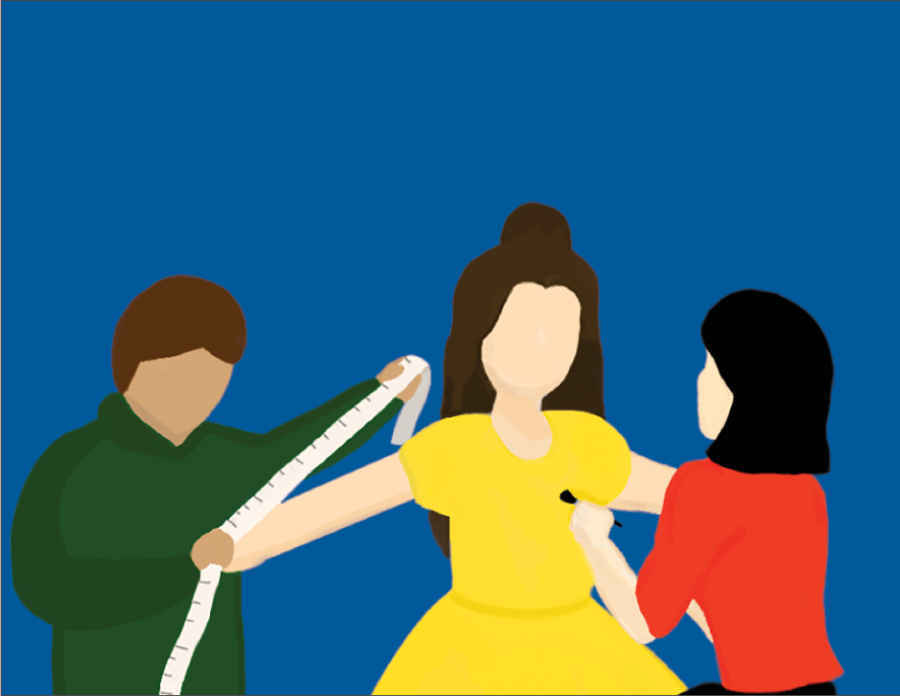Cue the crew
Let’s shine a spotlight on the hidden stars of Theatre West’s productions: the crew. From costume-making to hair-spraying, what can’t these folks do?
With the spring production of Beauty and the Beast coming up, now is the time to acknowledge the hard work of Theatre West’s various crews.
Hair and Makeup
Aside from shiny ball gowns and detailed props, hair and makeup play a key part in bringing characters to life. Alyssa Hagiwara ’23, the hair crew chief, emphasizes the importance of ensuring each hairstyle suits its character.
“We try to read the script and get a rundown of what the characters are like and how they’re depicted — old, young, rude, snobby — [to] decide which hairstyle would fit their characters,” Hagiwara said.
Makeup Crew Chief Willow Oleson ’23 says the creative process for her crew is similar. After the designs are approved by the directors, Oleson and Hagiwara meet with crew members to plan and gauge skill sets. From there, they wait for tech week, which is when they do hair and makeup tests on the actors.
“[Makeup] is one of the lowest time-commitment crews, but for the 20 minutes that everything needs to get done all at once, it can get very chaotic,” Oleson said.
Both Oleson and Hagiwara have found a fun and welcoming community through the cast and crew.
“It’s a close-knit group. We’re kind of like a cult,” Hagiwara said.
Costumes
French provincial clothing, a human candlestick and Belle’s iconic yellow gown: the costume crew has a lot on its plate for Beauty and the Beast.
“Once we get measurements [of the cast], I’ve already kind of got an idea of … my vision,” Costume Director Becky Deagle said. “I’ll go up to the loft and just start ruffling through all the costumes we have.”
If existing costumes aren’t enough, Deagle searches thrift stores or borrows from nearby drama departments. The crew then meets around three times per week, assembling the costumes and making alterations.
Costume Crew Chief Helenipa Stephens ’23 says an important part of the crew’s process is teaching sewing skills.
“As the show is happening, Becky will pull you aside and teach you different things. She’s a really good teacher [and] it’s a nice experience to learn as the show is happening,” Stephens said.
During the show, Stephens and the other students take the lead backstage, helping actors perform quick costume changes. Stephens enjoys the fast-paced nature of each show.
“When we’re backstage … in that rushed environment and that adrenaline kicks in, we’re all working together and it’s really nice,” Stephens said.
Lights and Sound
From a shining spotlight to a spooky glow, lighting is integral in setting the mood onstage. According to Lights Crew Co-Chief Lexie Vogt ’24, the nuance of lighting is sometimes overlooked.
“People might not realize that all the light isn’t just bright white. There’s always a color,” Vogt said.
These colors, along with factors like intensity and location, influence how the audience perceives a scene.
“You don’t realize how much of the emotion that you’re feeling comes from [the lighting] until it’s taken away,” Vogt said.
The crew starts working around two months before a show, reading through the script and programming cues on the lights board. During the show, Vogt and her co-chief, Alex Arens ’23, trade off running the board.
In addition to lights, sound is an essential component of every production. The sound crew begins training a few weeks before tech week to make sure all members know how to work the equipment.
“Our equipment is old and delicate, [so] it takes a lot of trial and error to figure everything out,” sound crew member Elizabeth Young ’25 said.
Set and Props
Often spotted drilling and painting after school, the set and props crews are essential in creating a realistic performance. Both crews start planning and meeting with directors a few months before the show.
Following meetings, the props crew searches their inventory for suitable items, according to former Props Crew Chief Rachel Swack ’23.
“We usually have most of [the props] already … they’ve been accumulating for so long,” Swack said.
Set-building is an intensive process that requires detailed considerations.
“We have to make sure [the set] is structural, especially if actors are dancing on it or interacting with it,” said Ali Hawkes ’24, one of the set crew chiefs. “Then we have to make it certain heights … so it’s proportional.”
As a senior, Swack reflects on her Theatre West experience.
“It’s really rewarding to get to this point,” Swack said. “You’re staring at it as a freshman like, ‘Wow, that’s going to be me soon.’ Now it’s me.”
Your donation will support the student journalists of West High School. Your contribution will allow us to purchase Scholarship Yearbooks, newsroom equipment and cover our annual website hosting costs.

(she/her) Maya is a senior and this is her third year on staff. She is the feature editor for print and is super excited for another great year. She loves...

(she/her) Esther Park is a sophomore at West High and this is her first year on staff. She is a designer and artist for the print publication. When she's...



